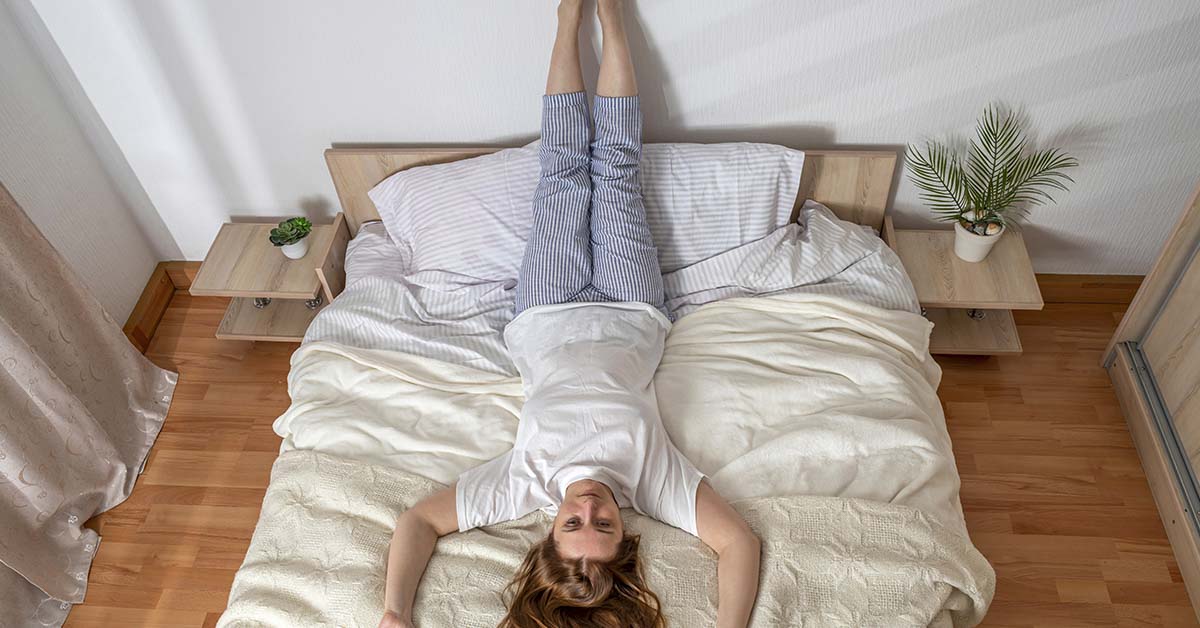You don’t need to attend a class to enjoy some of the benefits of yoga. Incorporating certain yoga poses into your routine can help in many different ways. For instance, certain poses are great for waking you up in the morning, and some can help with sleep if done before bed. And you can do certain poses at any time to relax and reduce stress, ease back pain, relieve bloating, improve balance, enhance flexibility, and support your posture. If you want to start small with one yoga pose, here’s a great one to add to your routine: viparita karani, also called legs-up-the-wall.
The benefits of viparita karani
Legs-up-the-wall falls under the category of inversion poses. “This means that the upper body is inverted from its normal, upright position,” says Robert Saper, MD, MPH, Chair of Wellness and Preventive Medicine. Another example is the classic downward-facing dog as well as headstands. But legs-up-the-wall is accessible for many people, even those who are yoga novices or struggle with other inverted poses. [1]
“The advantage of legs up the wall compared to a headstand or shoulder stand is that you’re able to achieve the benefits of inversion without stressing or straining your neck and head,” says Dr. Saper. Overall, people with spinal disorders and chronic neck pain shouldn’t do headstands or shoulderstands. But they can reap the benefits of inverted poses using legs-up-the-wall, which comes with its own unique virtues.
One of the main benefits of this pose is improved circulation. Poor circulation can lead to many discomforts. For instance, leg swelling due to venous insufficiency, where the blood ends up pooling in the legs and increases the risk of blood clots. Even those who don’t have chronic venous insufficiency may suffer from weak circulation if they tend to stand or sit for most of the day. Therefore, they can greatly benefit from this pose, as can people after a long flight or people with swollen legs or feet because of heat.
“The main benefit of viparita karani is that it puts back into circulation the bodily fluids stored in your legs,” says Dr. Saper. “By inverting and holding that pose, it allows the return of blood flow and reduction of lower-leg swelling.”
But that’s not the only perk. Yoga, in general, has been scientifically proven to reduce stress, and restorative poses like this one helps the body ease into a state of relaxation. “Many patients describe anecdotally they find holding the pose is very calming,” Dr. Saper says. Reducing stress has been linked to improved immune systems as well as overall improved mental and physical wellbeing.
Additional benefits
Improved circulation and relaxation can cause a positive ripple effect in the body. But it’s important to be wary of other claims about viparita karani, such as that it can help headaches and high blood pressure despite little to no evidence of this, according to Dr. Saper. However, individuals may experience certains benefits such as:
- Improved digestion
- Managed varicose veins
- Gently stretched hamstrings
- Relieved tension in the legs, feet, neck, and lower back
- Improved sleep
- Relieved leg and feet cramps
- Alleviated back pain
- Improved mood
- Relieved pain in the knees [2]
How to do the legs up the wall yoga pose
Begin by lying on the floor and scooting until your butt is against the wall. Slowly straighten your legs so that your body is in an L shape, with your back on the floor and your legs up the wall. Flex your feet to feel a stretch in the hamstrings. Breathe deeply and allow the body to relax into this pose. You can hold it for as long as it feels comfortable or up to 20 minutes. To get out of this pose, bring your knees toward your chest and roll to one side. Take your time sitting up.
This yoga pose has many variations and modifications, so you can tailor it to your body’s needs and enjoy different versions. For instance, use cushions or rolled-up blankets to support your head or neck. Variations include the butterfly pose, where instead of having the legs straight up the wall, bend your knees, bring the soles of your feet together, and let your feet come toward your pelvis while keeping them on the wall. Another variation involves keeping the legs straight but spreading them into a V shape to open the hips and stretch the inner thighs.
Of course, this is a yoga pose, so it’s important to draw your attention to your breathing. Focus on inhaling deeply through the nose, filling all of your lungs with air, then exhaling slowly while releasing the tension in your jaw, head, neck, shoulders, and back.
“As a researcher of yoga and a yoga instructor, I recommend this pose as part of an overall restorative yoga practice, done toward the end of your practice,” Dr. Saper says. For a video tutorial, see this video by Yoga by Adrienne.
Risks and considerations
Unfortunately, this pose is not for everyone. Avoid this pose if you’ve been diagnosed with glaucoma, hernia, uncontrolled high blood pressure, and conditions that cause excessive fluid retention like kidney failure, liver failure, and heart failure. Also, you may experience a tingling sensation after holding this pose for an extended period of time, or you can feel as if your legs and feet have fallen asleep. If this happens, shake your legs or bend your knees to stimulate circulation, or come out of the pose and walk around before resuming. [3]
Keep Reading: Yoga for Sciatica: 8 Poses in 8 Minutes for Back Pain Relief
Sources
- “The Yoga Pose You Need: The Health Benefits of Legs Up the Wall.” Cleveland Clinic. August 6, 2021
- “How to Do a Legs-Up-the-Wall Pose.” Healthline. Emily Cronkleton. November 23, 2020
- “What to Know About Legs-Up-the-Wall Yoga Pose.” WebMD. Martin Taylor. November 11, 2021

